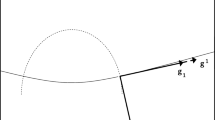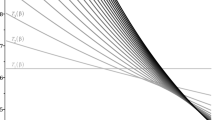Abstract
Magnetic fields in stars and planets are generated by a dynamo process that results from multi-scale interactions of the flows in conducting fluids. On the large scales, these flows are dominated by a strong zonal component, while the magnetic fields exhibit a strong toroidal/zonal character. Although dissipation certainly acts on these flows, the kinematic and magnetic viscosities associated with these large-scale flows are small, so that, over the timescale of several years and beyond, the system may be modelled as a conservative one. In this context, the Hamiltonian formulation may give several insights, providing a systematic way to relate the symmetries of the system with conservation laws. In the present article, we introduce the Hamiltonian formulation for a model that reasonably describes the dynamics of large-scale flows in stars and planets: the two-dimensional magnetohydrodynamic quasi-geostrophic equations. In this context, we find the invariants of the system, which are of two kinds: the Casimirs, related to the particle relabelling symmetry, and the zonal momentum, which is related to the translational invariance in the zonal direction. We then use these invariants to study the stability of some stationary solutions that are relevant for geophysical and astrophysical applications.
Similar content being viewed by others
Notes
We use the term referring to the variational formulation.
References
Arnold V (1966) Sur la géométrie différentielle des groupes de lie de dimension infinie et ses applications à l’hydrodynamique des fluides parfaits. Annales de L’institut Fourier 16(1):319–361
Buffett B (2014) Geomagnetic fluctuations reveal stable stratification at the top of the earth’s core. Nature 507(7493):484–487
Canet E, Finlay CC, Fournier A (2014) Hydromagnetic quasi-geostrophic modes in rapidly rotating planetary cores. Phys Earth Planet Inter 229:1–15
Cendra H, Holm DD, Marsden JE, Ratiu TS (1998) Lagrangian reduction, the Euler–Poincaré equations, and semidirect products. Transl Am Math Soc Ser 2(186):1–26
Dellar PJ (2003) Common Hamiltonian structure of the shallow water equations with horizontal temperature gradients and magnetic fields. Phys Fluids 15(2):292–297
Dikpati M, Cally PS, McIntosh SW, Heifetz E (2017) The origin of the “seasons’’ in space weather. Sci Rep 7(1):1–7
Dikpati M, McIntosh SW, Bothun G, Cally PS, Ghosh SS, Gilman PA, Umurhan OM (2018) Role of interaction between magnetic Rossby waves and tachocline differential rotation in producing solar seasons. Astrophys J 853(2):144
Dikpati M, Norton AA, McIntosh SW, Gilman PA (2021) Dynamical splitting of spot-producing magnetic rings in a nonlinear shallow-water model. Astrophys J 922(1):46
Flierl GR, Morrison PJ, Vilasur Swaminathan R (2019) Jovian vortices and jets. Fluids 4(2):104
Gilman PA (2000) Magnetohydrodynamic “shallow water’’ equations for the solar tachocline. Astrophys J Lett 544(1):79
Guerrero G, Smolarkiewicz P, Pino D, Kosovichev EDG, Mansour N (2016) On the role of tachoclines in solar and stellar dynamos. Astrophys J 819(2):104
Hide R (1966) Free hydromagnetic oscillations of the earth’s core and the theory of the geomagnetic secular variation. Philos Trans R Soc Lond Ser A Math Phys Sci 259(1107):615–647
Holm DD, Zeitlin V (1998) Hamilton’s principle for quasigeostrophic motion. Phys Fluids 10(4):800–806
Holm DD, Marsden JE, Ratiu T, Weinstein A (1985) Nonlinear stability of fluid and plasma equilibria. Phys Rep 123(1–2):1–116
Holm DD, Marsden JE, Ratiu TS (1998) The Euler–Poincaré equations and semidirect products with applications to continuum theories. Adv Math 137(1):1–81
Holm DD, Schmah T, Stoica C (2009) Geometric mechanics and symmetry: from finite to infinite dimensions, vol 12. Oxford University Press, Oxford
Javaraiah J, Bertello L, Ulrich R (2005) Long-term variations in solar differential rotation and sunspot activity. Solar Phys 232(1):25–40
Kaltsas D, Throumoulopoulos G, Morrison P (2020) Energy-Casimir, dynamically accessible, and Lagrangian stability of extended magnetohydrodynamic equilibria. Phys Plasmas 27(1):012104
Kueny C, Morrison P (1995) Nonlinear instability and chaos in plasma wave–wave interactions. I. Introduction. Phys Plasmas 2(6):1926–1940
Majda A (2003) Introduction to PDEs and waves for the atmosphere and ocean, vol 9. American Mathematical Society, Providence
Majda A, Wang X (2006) Nonlinear dynamics and statistical theories for basic geophysical flows. Cambridge University Press, Cambridge
Marsden JE, Hughes TJ (1994) Mathematical foundations of elasticity. Courier Corporation, Chelmsford
Marsden JE, Ratiu TS (2013) Introduction to mechanics and symmetry: a basic exposition of classical mechanical systems, vol 17. Springer, Berlin
Morrison PJ (1998) Hamiltonian description of the ideal fluid. Rev Mod Phys 70(2):467
Morrison PJ, Greene JM (1980) Noncanonical Hamiltonian density formulation of hydrodynamics and ideal magnetohydrodynamics. Phys Rev Lett 45(10):790
Morrison PJ, Hazeltine RD (1984) Hamiltonian formulation of reduced magnetohydrodynamics. Phys Fluids 27(4):886–897
Morrison P, Kotschenreuther M (1990) The free energy principle, negative energy modes, and stability. Technical report, Texas University, Austin (USA)
Morrison PJ, Pfirsch D (1989) Free-energy expressions for Vlasov equilibria. Phys Rev A 40(7):3898
Raphaldini B, Raupp CF (2015) Nonlinear dynamics of magnetohydrodynamic Rossby waves and the cyclic nature of solar magnetic activity. Astrophys J 799(1):78
Raphaldini B, Raupp CF (2020) Nonlinear MHD Rossby wave interactions and persistent geomagnetic field structures. Proc R Soc A 476(2241):20200174
Raphaldini B, Teruya AS, Raupp CF, Bustamante MD (2019) Nonlinear Rossby wave–wave and wave–mean flow theory for long-term solar cycle modulations. Astrophys J 887(1):1
Salmon R (1988) Hamiltonian fluid mechanics. Annu Rev Fluid Mech 20(1):225–256
Shepherd TG (1990) Symmetries, conservation laws, and Hamiltonian structure in geophysical fluid dynamics. In: Advances in geophysics vol 32. Elsevier, Amsterdam, pp 287–338
Tassi E, Chandre C, Morrison PJ (2009) Hamiltonian derivation of the Charney–Hasegawa–Mima equation. Phys Plasmas 16(8):082301
Thomas JH, Weiss NO (2012) Sunspots: theory and observations, vol 375. Springer, Berlin
Zeitlin V (2013) Remarks on rotating shallow-water magnetohydrodynamics. Nonlinear Process Geophys 20(5):893–898. https://doi.org/10.5194/npg-20-893-2013
Acknowledgements
BR and MD acknowledge support from the National Center for Atmospheric Research, which is a major facility sponsored by the National Science Foundation under cooperative agreement 1852977, and also acknowledge partial support from NASA grants, such as NASA-LWS award 80NSSC20K0355 (awarded to NCAR) and NASA-HSR award 80NSSC21K1676 (awarded to NCAR). CR acknowledges the support from Coordenação de Aperfeiçoamento de Pessoal de Nível Superior—Brasil (CAPES)—Finance Code 001. CR dedicates this article to the memory of his father, Marco Antônio Raupp, an exemplary mentor.
Author information
Authors and Affiliations
Corresponding author
Ethics declarations
Conflict of interest
We declare no conflict of interests.
Data availability
Data sharing is not applicable to this article as no new data were created or analyzed in this study.
Additional information
Communicated by Eduardo Souza de Cursi.
Publisher's Note
Springer Nature remains neutral with regard to jurisdictional claims in published maps and institutional affiliations.
Appendix: Differential forms representation of magnetic fields
Appendix: Differential forms representation of magnetic fields
The representation of magnetic fields in terms of differential form is given in terms of 2-forms. First introduce the following operations, first the isomorphism that takes vector field on \({\mathbb {R}}^3\) to 1-forms \(^{\flat }:{T^{{\mathbb {R}}^{3}}}\rightarrow T^{*}{\mathbb {R}^{3}}\) defined by
\(i=1,2,3\), where \(\{e_1,e_2,e_3\}\) is the basis of \(\mathbb {R}^3\), the inverse isomorphism,\(^{\flat }:T\mathbb {R}^3\rightarrow T^{*}\mathbb {R}^3\), is defined by
Finally, introduce the Hodge star operator that takes l forms to \(n-l\) forms in \(\mathbb {R}^n\). In \(\mathbb {R}^3\),
With this, a given magnetic field, \( {B}=B_1 e_1 + B_2 e_2+B_1 e_3 \), is expressed by the following differential form
the law on non existence of magnetic monopoles \(\nabla .{\textbf {B}}=0\) is them expressed as
which implies, by Poincare’s Lemma in the existence (at least locally) in the existence of a 1-form such that \(\beta =d \alpha \), from which we define the vector potential \({\textbf {A}}\)
For an Euler–Poincaré equations with advected quantities (Holm et al. 2009) the variations in the action with respect with the advected quantity (\({\textbf {A}}\) or \({\textbf {B}}\)) is of the form
We need to calculate the Lie derivatives of these forms
and
Rights and permissions
Springer Nature or its licensor (e.g. a society or other partner) holds exclusive rights to this article under a publishing agreement with the author(s) or other rightsholder(s); author self-archiving of the accepted manuscript version of this article is solely governed by the terms of such publishing agreement and applicable law.
About this article
Cite this article
Raphaldini, B., Dikpati, M. & Raupp, C.F.M. Quasi-geostrophic MHD equations: Hamiltonian formulation and nonlinear stability. Comp. Appl. Math. 42, 57 (2023). https://doi.org/10.1007/s40314-023-02192-2
Received:
Revised:
Accepted:
Published:
DOI: https://doi.org/10.1007/s40314-023-02192-2
Keywords
- Quasi-geostrophic MHD equations
- Astrophysical flows
- Non-canonical Hamiltonian formulation
- Noether’s theorem
- Energy-Casimir method




